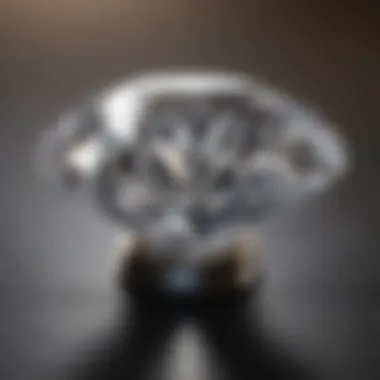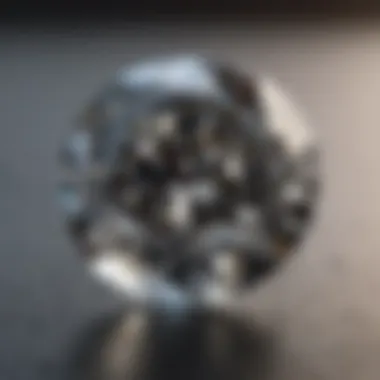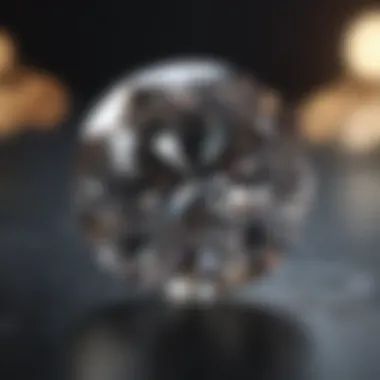The Ultimate Guide to Best Diamond Certification


Intro
In the realm of gemstones, diamonds hold a unique and revered position. Their resplendent beauty and exceptional hardness have made them not only coveted jewelry pieces but also symbols of status and wealth. Yet, the intricacies of diamond certification can be daunting for those outside of the industry. This guide aims to demystify the process, shedding light on the most esteemed certification institutions, the methodologies they employ, and the significance of these certifications in determining the quality and value of diamonds.
Certification does not merely serve as a formality; it acts as a pivotal element in a buyer's decision-making process. Understanding certification grades can influence market values and consumer choices alike. For enthusiasts, collectors, and conscientious buyers, an awareness of how to interpret these reports is essential for navigating the complex landscape of diamond evaluation. Thus, this discourse will explore the key elements of diamond certification systematically, providing clarity and depth to this critical aspect of gemstone acquisition.
Gemstone Overview
Definition and Origins
Diamonds are a crystalline form of carbon, forming under immense heat and pressure in the Earth's mantle over the course of millions of years. Their origins date back billions of years, with their journey to the surface often facilitated by volcanic eruptions. As a result, diamonds are not merely geological phenomena; they embody ancient histories of the Earth.
Historical Significance
Throughout history, diamonds have transcended their physical attributes. They have been worn by monarchs, featured in required rituals, and even used as currency. The historical significance of diamonds goes beyond mere adornment; they have often symbolized power, love, and commitment, with the phrase "a diamond is forever" entrenched in cultural narratives.
In exploring diamonds, one begins to appreciate not only their aesthetic appeal but also their storied past and the profound connections they foster among people. Understanding these origins and significances lays a robust foundation for our discussion on certification, which will follow in the subsequent sections of this guide.
Understanding Diamond Certification
Understanding diamond certification is a crucial first step for anyone interested in buying or investing in diamonds. This process offers vital information about the stone's quality and authenticity. Knowing how certification works helps consumers make more informed choices, ensuring they receive a fair value for their investment.
Definition of Diamond Certification
Diamond certification refers to the process by which a gemological laboratory assesses and grades a diamond based on specific criteria. Each diamond that is certified comes with a report that details its characteristics. These reports are crucial for buyers as they provide an unbiased evaluation of the diamond's features.
The main characteristics noted in a certification report include cut, color, clarity, and carat weight—often referred to as the "Four Cs." Each of these attributes contributes to the overall quality and value of the diamond. Institutions like the Gemological Institute of America (GIA) or the American Gem Society (AGS) conduct these evaluations, utilizing strict standards and precise methods.
Importance of Diamond Certification
The importance of diamond certification cannot be overstated. A certified diamond has undergone thorough scrutiny, ensuring the buyer is aware of what they are purchasing. Certified diamonds typically command higher prices in the market, as buyers feel secure knowing they are investing in a quality product.
Moreover, certifications help to standardize the grading process within the industry. Without a consistent grading system, consumers could easily be misled about a diamond's true value. By relying on respected institutions for certification, buyers are better equipped to recognize quality and avoid scams.
"A verified diamond not only assures the buyer of its quality but also enhances the overall market value."
Furthermore, having a certified diamond can benefit resellers or collectors in the future. Should one choose to sell their diamond, the certification adds credibility and can significantly influence the sale price. It ensures potential buyers that the diamond was evaluated by a recognized authority.
The Leading Diamond Certification Institutions
In the complex landscape of diamond buying, understanding the leading diamond certification institutions is crucial. These organizations set the standards for grading diamonds, ensuring transparency and reliability. With an array of grading systems, institutions provide buyers with the necessary tools to discern quality and value. This section will delve deep into the most reputable certification bodies, exploring their specific methodologies and the advantages they bring to the gemstone market.
Gemological Institute of America (GIA)
The Gemological Institute of America, commonly known as GIA, holds a prominent position in the diamond certification space. Founded in 1931, GIA is widely recognized for its rigorous grading practices and educational programs. They developed the 4Cs system�—cut, color, clarity, and carat weight—which serves as the foundation for diamond evaluation worldwide.
The grading reports from GIA are considered authoritative and transparent. Each report contains detailed information about the diamond, including visual representations and precise measurements. GIA employs advanced equipment for accurate grading, combining both science and artistry in its assessments. Buyers can trust GIA-certified diamonds, knowing they reflect genuine qualities.


American Gem Society (AGS)
American Gem Society, or AGS, has been a leading authority in gemology since its establishment in 1934. AGS is particularly noted for its unique cut grading system, which classifies diamonds based on light performance. This focus on how the diamond interacts with light sets AGS apart from other institutions.
The AGS's grading reports include detailed metrics on cut, color, clarity, and carat weight, much like GIA. However, AGS pays special attention to cut quality, providing consumers with insights that are directly related to the diamond's sparkle and brilliance. Purchasing a diamond with an AGS certification often leads to enhanced visual appeal, making it a preferred choice for many buyers.
International Gemological Institute (IGI)
The International Gemological Institute, known as IGI, is another significant institution in the diamond certification field. Established in 1975, IGI has grown to become one of the largest gem certification authorities worldwide. They offer a comprehensive grading system that evaluates diamonds on a variety of criteria including the famed 4Cs.
IGI grading reports are respected by both dealers and consumers. These reports provide a balance of in-depth analysis and accessibility, making them a practical choice for buyers. IGI’s global reach also ensures that their certifications are accepted in many markets, giving consumers confidence in their purchase.
Other Notable Certification Organizations
Besides GIA, AGS, and IGI, several other institutions contribute to the diamond certification landscape. These include:
- European Gemological Laboratory (EGL): Known for providing more lenient grading, EGL reports can present different assessments than other organizations.
- American Gem Trade Association (AGTA): This organization focuses primarily on colored gemstones but also offers diamond certification.
- Hamanaka Gemological Institute: Based in Japan, they provide certifications focusing on a range of gemstones including diamonds.
Each of these institutions has its strengths and target markets. Understanding their differences assists buyers in making informed choices.
Choosing a diamond without understanding its certification can lead to costly mistakes. Make sure to verify the certification details when purchasing.
Assessment Criteria in Diamond Certification
In the realm of diamond certification, assessment criteria hold paramount importance. They guide the evaluation of a diamond’s quality, determining its value and desirability in the market. Understanding these criteria is crucial for anyone involved in diamond purchasing and investment, be it collectors, enthusiasts, or jewelry designers. The main criteria include cut, color, clarity, and carat weight, commonly referred to as the "Four Cs." Each of these factors contributes uniquely to the assessment process, affecting both the aesthetic appeal and financial worth of diamonds.
Cut Quality
Definition of Cut
Cut refers to how well a diamond has been shaped and faceted. It is not merely about the physical shape, but also about how light interacts with the diamond. A well-cut diamond will demonstrate brilliance and sparkle, resulting in a captivating appearance. This aspect is critical since it significantly influences a diamond's visual properties. High-quality cut enhances the overall beauty, making it a preferred choice for buyers seeking both aesthetics and value.
Factors Influencing Cut Quality
Several elements govern the quality of a diamond's cut. The proportions of the diamond, the angle of the facets, and the craftsmanship involved are all critical aspects. The proportions must allow for optimal light performance, which results in greater brilliance. While a diamond can have exceptional color and clarity, a poor cut can diminish its overall appearance. The importance of cut quality cannot be overstated; it is often said to be the most significant factor affecting a diamond’s desirability.
Color Grading
Understanding Color Scales
Color grading involves assessing the presence of color in a diamond, which can range from completely colorless to various shades of yellow or brown. The Gemological Institute of America (GIA) color scale, for example, grades diamonds from D (colorless) to Z (light yellow). Understanding these color scales is vital for buyers as they directly influence a diamond's value. Typically, the rarer the stone, the higher its price.
Impact on Value
The intensity of a diamond’s color significantly impacts its market value. Colorless diamonds are in high demand and often command premium prices. Conversely, diamonds with more noticeable colors might be less desirable, affecting their pricing. Knowing how color grading works informs consumers and investors in making better decisions, aiming to maximize both quality and investment potential.
Clarity Assessment


Definitions of Clarity
Clarity describes how clear a diamond is, assessing the presence of inclusions or blemishes. Clarity grades range from flawless (no inclusions visible under 10x magnification) to included (inclusions visible to the naked eye). Understanding clarity definitions is essential for assessing the potential worth and appeal of a diamond. A higher clarity often leads to higher value, making this criterion crucial in certification.
Visual Flaws and Inclusions
Inclusions are internal faults, while blemishes are external, both of which can affect a diamond's aesthetic. The presence of such flaws impacts visual perfection and can lower a diamond’s worth. A deeper understanding of these flaws helps consumers make informed choices and avoid overpaying for stones that may not meet their expectations. Therefore, clarity assessment plays a significant role in the overall evaluation process.
Carat Weight
Understanding Carat Measurement
Carat weight refers to the size of a diamond and is a critical factor in its valuation. One carat equals 200 milligrams. While size tends to attract attention, it is essential to consider carat weight alongside other criteria, as larger diamonds are rarer and typically more expensive. Understanding how carat weight correlates with overall quality is key for potential buyers.
Impact on Price
Carat weight directly influences price. Larger diamonds generally carry a significantly higher cost per carat compared to smaller ones. However, other factors, such as cut, color, and clarity, also play roles in determining overall value. Thus, buyers need to consider carat weight in conjunction with other assessment criteria to make a well-rounded decision that aligns with their budget and preferences.
How to Read a Diamond Certificate
Understanding how to read a diamond certificate is pivotal for any consumer serious about purchasing a diamond. A certificate provides essential information about the diamond's characteristics and quality, acting as a guide to its value and authenticity. By analyzing a certificate closely, buyers can make informed decisions that align with their preferences and budget.
Decoding the Certification Report
The certification report is a detailed document that explains the various attributes of a diamond. Each section of the report provides critical insights into aspects like carat weight, clarity, color, and cut. Here are the main components typically found in a certification report:
- Carat Weight: This indicates the weight of the diamond measured in carats. One carat equals 0.2 grams. Higher carat weight can often lead to higher prices, but the value also depends on other quality factors.
- Cut Quality: This describes how well the diamond has been shaped and faceted. A well-cut diamond reflects light beautifully, enhancing its brilliance and fire.
- Color Grade: This measures the colorlessness of the diamond. The grading scale ranges from D (colorless) to Z (light yellow or brown).
- Clarity Grade: This signifies the presence of internal or external flaws known as inclusions and blemishes. Clarity grading ranges from Flawless to Included.
- Polish and Symmetry: These are additional quality indicators, showing how well the diamond has been finished and how aligned its facets are.
Each institution may have slight variations in their reports, so familiarity with the specific formats is beneficial.
"A diamond certificate is not just a piece of paper; it is a buyer's best reference to authenticate the stone's quality."
Common Terminology Explained
When reading a diamond certificate, it is crucial to grasp common terminology associated with diamond grading. Here are some key terms that frequently appear:
- GIA (Gemological Institute of America): Renowned for providing high-standard grading for diamonds. Knowing this can lend credibility to the certification.
- AGS (American Gem Society): Another trusted body known for rigorous grading standards.
- Inclusion: A term referring to internal flaws within the diamond. Their type and number significantly affect the diamond's clarity grade.
- Blemish: This indicates external flaws such as scratches or chips on the diamond’s surface.
- Twinning Wisp: A specific type of inclusion; its presence can affect the overall clarity grade.
- Fancy Color: Diamonds that possess a color significantly alter their market value. Understanding this classification helps in making the right choice.
Familiarizing oneself with these terms enhances the reading of a diamond certificate, making it easier to assess the value of a diamond. Knowing what these terms mean allows buyers to compare diamonds effectively and select the one that meets their desires and budget.
The Role of Certification in Valuation
The role of diamond certification in valuation is multifaceted. First, certification provides a formal assessment of a diamond's attributes, such as cut, color, clarity, and carat weight. These factors are essential in determining a diamond's market price. When a diamond comes with a recognized certificate, buyers can have greater confidence in its quality. This certificate acts as a standardized reference, helping to mitigate discrepancies that can arise from subjective evaluations.
Furthermore, the existence of a certification can significantly enhance a diamond's salability. For many buyers, especially in the luxury market, a certified diamond is more appealing. This interest is driven by the assurance that the stone meets certain quality baselines and has been evaluated by a legitimate authority within the industry. A recognized certificate from institutions like the Gemological Institute of America or the American Gem Society can elevate consumer perception, making diamonds with such certifications very sought after.
Market Perception of Certified Diamonds


Market perception of certified diamonds is largely shaped by consumer trust. Certifications from reputable organizations signal reliability and authenticity. Buyers often perceive certified diamonds as superior products compared to non-certified ones. This perception affects not only retail prices but also resale values. A certified diamond generally retains its value better than an uncertified one due to the perceived assurance of quality.
Moreover, in today’s digital age, information about diamonds can be widely disseminated. Online platforms and social media provide diamonds with more visibility. Positive reviews and feedback on certified stones further enhance their market status. Such ecosystems create a cycle where high-quality, certified diamonds increase consumer confidence, leading to higher demand.
Investment Considerations
Investing in certified diamonds involves several considerations. For potential investors, certification can indicate long-term value retention. When diamonds are appraised and certified, their quality is clearly established. This transparency is important in the investment landscape, where knowing the precise quality of an asset is key to making informed decisions.
Potential investors should be aware, however, that while certification enhances the diamond's value, it is not the sole determinant of worth. Market trends and collector preferences fluctuate. For instance, certain styles or colors of diamonds may become more sought after, affecting investment angles. Investors should keep abreast of these trends alongside understanding the certification standards.
"A diamond's certification alone does not guarantee its future appreciation, but it certainly serves as a crucial building block for establishing trust and value in the market."
Challenges within the Certification System
The challenges faced within the diamond certification system are significant. They create uncertainties for buyers, especially with the high investment associated with diamonds. Understanding these challenges is essential, as potential buyers and enthusiasts need to navigate a system fraught with inconsistencies and risks. By grasping the factors involved, one can make informed choices and appreciate the complexities of evaluating diamond worth.
Variability in Grading Standards
Variability in grading standards is one of the most prominent challenges in the certification system. Different certification organizations often employ their own grading criteria. This can result in discrepancies in how diamonds are assessed, particularly in terms of quality attributes such as cut, color, clarity, and carat weight.
For example, the Gemological Institute of America (GIA) and the International Gemological Institute (IGI) may have subtle differences in their evaluation processes. A diamond graded as "Excellent" by GIA might receive only a "Very Good" rating from IGI. This inconsistency can be misleading for potential buyers who may assume that all certifications hold equal weight.
The variability can affect the market, as diamonds certified by one institution may garner higher prices than similar stones evaluated by another. Buyers should be cautious and research the specific grading criteria used by each organization to ensure they understand what they are purchasing.
Fraudulent Certificates
Fraudulent certificates pose a serious threat within the diamond certification landscape. As the demand for diamonds rises, so does the potential for dishonest practices. Unscrupulous sellers may issue fake certifications or manipulate legitimate ones to inflate the value of a diamond.
Such fraudulent activities can lead to significant financial losses for unsuspecting buyers. It is critical to verify the authenticity of a diamond's certification. This can often be done by contacting the certifying institution directly.
When purchasing a diamond, always demand the original certificate and check its details against the certifying body’s database when available. Not only does this practice safeguard your investment, but it also promotes integrity in the diamond market.
"Understanding the challenges in diamond certification helps buyers protect their investment and promotes a transparent market."
By addressing these challenges head-on, the diamond buying process can become more transparent and reliable. Awareness of grading standard variability and fraudulent certificates are crucial steps toward making informed decisions in the complex world of diamond purchasing.
Future Trends in Diamond Certification
The landscape of diamond certification is evolving. With advancements in technology and shifts in consumer preferences, it is crucial to understand how these factors influence the certification process and market dynamics. Embracing future trends in diamond certification can enhance quality assurance, improve transparency, and ultimately shape the decisions of buyers and sellers alike.
Technological Advancements
Technology has became a game-changer in diamond certification. Automated grading tools are being developed, which promise to enhance consistency and accuracy in evaluations. Machines can now assess diamond attributes like color, cut, clarity, and carat with exceptional precision. This removes human error, setting a new standard for grading reliability.
Notably, the use of imaging technology has increased. High-resolution scans create 3D models of diamonds, allowing a detailed examination of facets and clarity. As a result, buyers can visualize and assess a diamond without physically handling it. This innovation not only builds trust among consumers but also broadens their understanding of diamond values.
Blockchain technology is also making its mark. This tech can track the provenance of diamonds, ensuring ethical sourcing and reducing the risk of fraud. Transparency offered by blockchain aligns with growing consumer awareness and demand for responsible purchasing decisions. In the future, it is likely that more certification bodies will adopt this technology, enhancing the credibility of certifications.
Changing Consumer Demands
As awareness regarding ethical and sustainable practices rises, consumers have begun demanding more from the diamond industry. Modern buyers are inclined toward diamonds that are sourced responsibly and comply with ethical standards. This shift has pressured certification institutions to incorporate ethical guidelines into their grading procedures.
Furthermore, consumers today seek detailed information about the diamonds they purchase. They want certifications that provide comprehensive insights, not just grades. Buyers increasingly value transparency regarding the diamond's journey from mine to market. In response, certification organizations need to develop more informative and encompassing reports that help consumers make informed decisions.
The trend of customization is shaping consumer preferences too. Clients are requesting unique designs and specific characteristics in diamonds, leading to more demand for personalized evaluations. Certification institutions that can adapt to providing bespoke services will likely thrive in this competitive environment. This approach could transform how certificates are issued, catering to individual buyer requirements.



